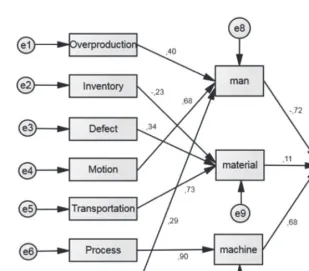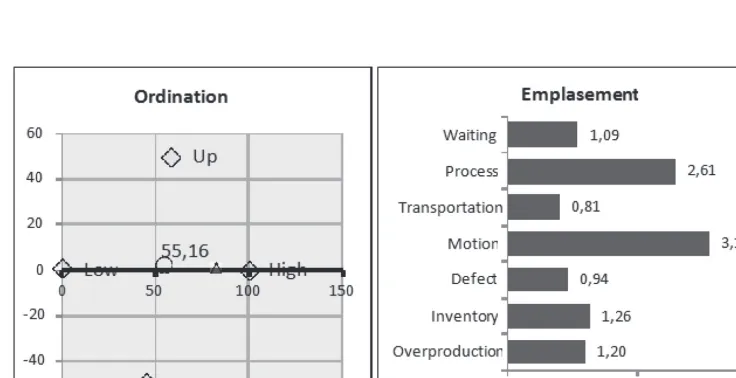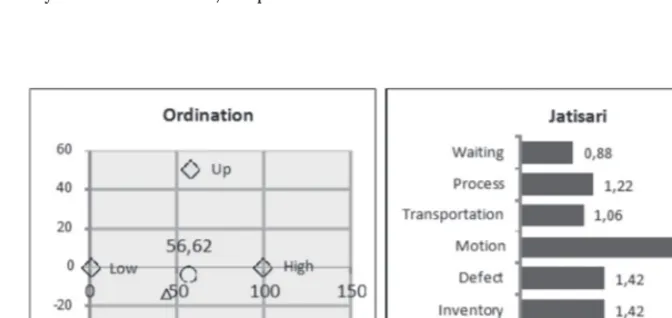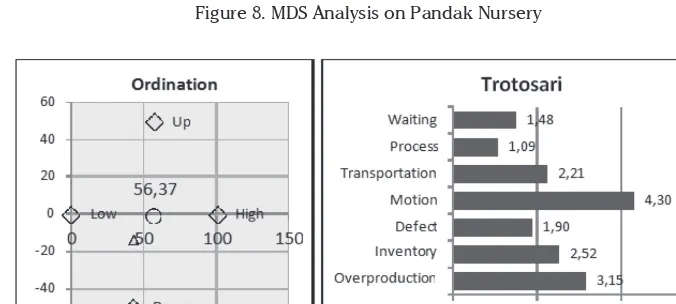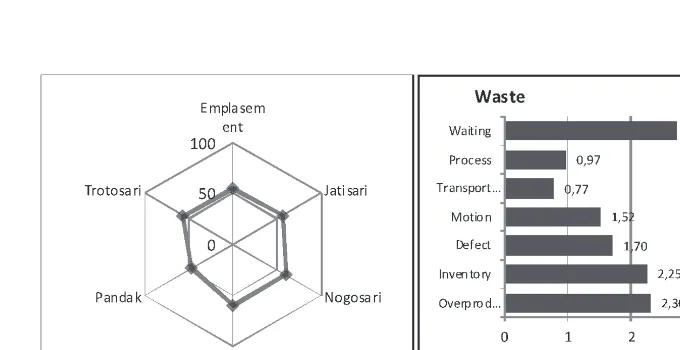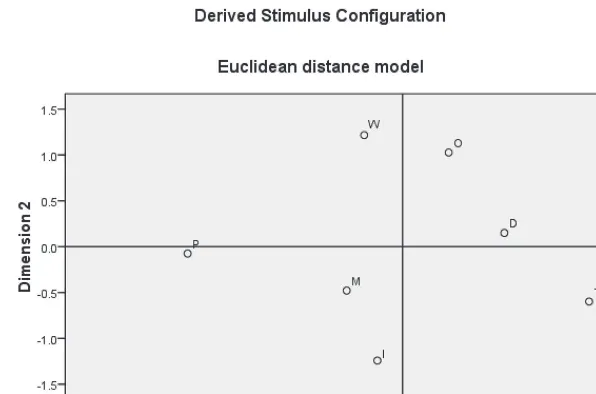Forest destruction both in the form of deforestation and degradation continues. Forest management on the basis of partnership with the community is also one of forest management methods to tackle deforestation. Agroforestry company has a commitment to support legal teak supplies and support teak forest afforestation. Plant breeding efforts were being undertaken all national agroforestry company and implemented in cooperation with BPPT as a partner to obtain superior teak plants. A problem in producing a superior teak seedling is the high cost of seed production. Because of this, teak seedlings produced. Materials used for the study were obtained from questionnaires carried out by employees. The data were analyzed using descriptive analysis, structured equation model and value stream analysis tools. The results reveal that the main factors affecting the production process of teak seedlings are transportation, process, human, material and machine. The improvement of production system teak seedlings will be applied in the following order of priority: transportation with 60.8% influential level, motion with 49.5% effective level, defect with 3.8% influential level, and inventory with 2.5% influential level.
Kerusakan hutan, baik dalam bentuk deforestasi maupun degradasi terus berjalan. Pengelolaan hutan dengan basis kemitraan dengan masyarakat juga merupakan salah satu metode pengelolaan hutan untuk menanggulangi deforestasi. PT. Harfam Jaya Makmur, sebagai sebuah perusahaan agroforestri memiliki komitmen untuk mendukung penyediaan kayu jati legal dan mendukung aforestasi hutan. Upaya pembibitan yang dilakukan oleh PT. Harfam Jaya Makmur dilaksanakan dengan menggandeng BPPT sebagai mitra untuk mengupayakan tanaman jati unggul. Permasalahan yang dihadapi untuk menciptakan bibit jati unggul adalah tingginya biaya produksi bibit, hal ini menyebabkan bibit jati produk PT. Harfam Jaya Makmur memiliki harga yang lebih tinggi. Penelitian dilakukan bulan Maret – Mei 2015 di hutan jati di Kabupaten Situbondo dan Kabupaten Bondowoso yang dikelola oleh PT Harfam Jaya Makmur. Bahan yang digunakan berasal dari pengisian kuesioner yang dilakukan oleh
Keywords: Forest, Deforestation, Business Processes, Teakwood
Corresponding author: 1malkaff@gmail.com
Muhammad Alkaff, Marimin, Yandra Arkeman, Sukardi, Herry Purnomo
Bogor Agricultural University, Jl Dramaga, Babakan, Dramaga, Bogor, 16680, Jawa Barat, IndonesiaA R T I C L E I N F O A B S T R A C T
Vol. 9 | No. 3 ISSN: 2089-6271 | e-ISSN: 2338-4565
Business Process Reengineering of Sustainable
Teak Forest at Agroforestry Industry
INTRODUCTION
Deforestation is the conversion of land cover from forest to non-forested land use including plantation, settlement, industrial area and others. The Directorate of Forest Resources Inventory and Monitoringreported that 610,375.9 hectares of Indonesian forest were deforested.
Forest and land rehabilitation are intended to restore, maintain and improve forests and land functions so that its capacity, productivity, and roles in maintaining the life support system are well preserved. Previously implemented forest rehabilitation includes reforestation, re-vegetation, plants maintenance, enrichment planting, and implementation of vegetative and engineering land conservation techniques to critical and unproductive lands.
Community-partnership-based forest manage-ment is also a forest managemanage-ment method applied to deal with deforestation. It takes forms into or-ganizations like Community Collaborative Forest Management, Nusantara Wanabakti Housing Coo-perative, PT. HARFAM and other forums of com-munity based forest management.
Teak cultivation prospect in Indonesia is experiencing a relatively good business cycle due to furniture industry mostly in Central Java where it has high potential. As an example wood consumption in Jepara was 1.5 to 2.2 million cubic
meter. This is higher than the wood production figure that was officially reported by Forestry Ministry stating that the wood production in all areas in Java is 923,632 cubic meter (Roda et al, 2007). Furniture industry, however is facing some problems like an unbalance situation of high demand and low availability of raw material, unfair competitiveness, raw material scarcity, wide varied rate price of raw material provided by wood suppliers, unevenly distribution of added value, very low access of market information and requirement for legal certification of raw material. These situations have triggered some teakwood illegal supplies either from Java Island or other islands in Indonesia. That happened because of raw material scarcity (Effendy & Parlinah, 2010).
Some agroforestry company is committed to supporting legal teak supply. It provides high quality teak seedlings, develops productive forests and invites its business partners to develop afforestation together with plantation company.
The problems in developing superior teak seedlings are high cost of seedling production. That is why the company’s seedlings are more expensive than those produced by other companies. As a result, the seedlings are not put up for sale but planted mostly only on the forests and land of the company and its business partners.The company is able to sell only a small number of teak seedlings to other organizations. To resolvethe situation the company karyawan PT. Harfam Jaya Makmur. Analisis data yang digunakan meliputi analisis deskripsitf, structured equation model dan value stream analysis Tools. Hasil penelitian menunjukkan faktor utama yang mempengaruhi proses produksi bibit jati pada PT. Harfam jaya makmur adalah faktor transportasi, proses, man, material dan machine. faktor yang menjadi prioritas dalam perbaikan dalam sistem produksi bibit jati di PT. Harfam jaya makmur dengan urutan prioritas sebagai berikut transportation dengan kuat pengaruh 60,8%, motion dengan kuat pengaruh 49,5%, defect karena dengan kuat pengaruh sebesar 3,8% serta Inventory dengan kuat pengaruh sebesar 2,5%.
needs to make its production process more efficient while maintaining the seedling quality. Based on the need, the study is prepared and it
isintended to reassess, analyze and reengineer the seedling production process.
The framework in this study is as follows:
Phenomenon
1. Environmental pollution increases due
to growing number of industries that discharging liquid, gaseous and solid waste.
2. Indonesian forest cover decreases from
98.56 millionhectares in 2010 to 45 millionhectares in 2012
Partnership based forest management in Indonesia
Agroforestry Industry
Process Business Reengineering
Current State Value Stream Mapping
Waste Identification and Assessment
Waste Analysis
Performance Improvement Strategy
Future State Value Stream Mapping
Future State Value Stream Mapping
METHODS
This study used an approach of descriptive method and made use of the business cases of teakwood afforestation. The data obtained will be analyzed qualitatively and quantitatively. The purpose of this analysis is to examine and obtain a description of the business processes of teak forest afforestation.
The primer data obtained from direct interview with and questionnaire completion by the respondents that consisted of experts, practitioners and stockholders of Agroforestry Industry. Questionnaires were used to collect their opinion regarding teakwood afforestation business process that had been identified based on the analysis upon the collected data and information. The interview was intended to collect information and inputs based on the stakeholder’s practical experience and knowledge on afforestation business of tree or teakwood planting.
The data collecting process used expert survey that was interviewing thoroughly the experts relevant with their individual expertise. Observation was also carried out to obtain data and information that would be used to analyze the supply
chain of teakwood afforestation. Meanwhile, questionnaires or list of questions regarding the business process and waste in the company were administered to the employees and its relevant parties.
The research employed the following methods: Value Stream Mapping, waste identification, Waste Relationship Matrix (WRM), Value Stream Analysis Tools (VALSAT), Model Analysis and Multidimentional Scale Analysis.
RESULTS AND DISCUSSION
A. Waste Analysis on Production Process
Seedling production process is a problem which all Agroforestry Company is facing today. Teak seedling as one of the company’s products demands high investment and head costs.
Based on the teak seedling production process, an assessment was conducted to the waste of each process in each production location. The locations was studied are the Emplacement, Jatisari, Nogosari, Cangkring, Pandak and Trotosari. In the Emplacement, the process started with parent plant and ended in distribution. Not all
Emplacement products could be acclimated in the area after incubation so that they were distributed to the other locations.
B. Production Model Analysis
In order to find the correlation of production factors and waste in the teak seedling production system
at the company a Structured Equation production
model analysis was conducted. The results are as shown in figure 3.
The figure presents the estimated value and
t-value. The red t-value indicates that the t-value
obtained (1.96) is lower than the t-table value on 5% level of significance. It means the variable is not significant. Table 1 shows clearly whether or not the values are significant.
Table 1 of structural model t-value and coefficient
reveal the following:
a. Waste motion (t-value = 2.86) significantly contributes to man in factor influencing the amount of waste.
b. Waste overproduction (t-value = 1.67)
notsignificantly contributes to man factor in influencing the amount of waste.
c. Waste waiting (t-value = 1.23) notsignificantly contributes to man factor in influencing the amount of waste.
d. Waste transportation (t-value = 2.92) significantly contributes to materialfactor in influencing the amount of waste.
e. Waste inventory (t-value = -0.92)
notsignificantly contributes to materialfactor in influencing the amount of waste.
f. Waste defect (t-value = 1.36) notsignificantly contributes to materialfactor in influencing the amount of waste.
g. Waste process (t-value = 4.56) significantly contributes to machinefactor in influencing the amount of waste.
h. Man factor significantly contributesto the amount of waste (t-value = -21.39).
i. Material factor significantly contributesto the amount of waste (t-value = 3.33).
j. Machine factor significantly contributesto the amount of waste (t-value = 20.01).
1. Indirect Effect
Indirect effect is the influence of exogenous variables to endogenous dependent through endogenous intervening variables. The indirect influences are presented in Table 2.
a. Indirect effect of Waiting to Waste
Research results reveal that indirect effect of waiting factor on the amount of waste
through man factor (W→man→waste)is
-0.2132, meaning that waiting factor indirectly effectsamount of waste through man factor with value of 21.3%. Since the direct effect of waiting to man factor is not significant, the indirect effect of waiting to waste through man factor is therefore not significant.
b. Indirect Effect of Transportation on Waste Research results reveal that indirect effect of transportation on the amount of waste through material factor (T→material→waste) is 0.0819, meaning that transportation indirectly effects amount of waste through material factor is 8.1%. Since the direct effect of transportation on material factor is significant,the indirect effect of transportation on waste through material factor is therefore significant.
c. Indirect Effect of Motion on Waste
Research results reveals that indirect effect of motion on the amount of waste through
material factor is (M→man→waste) -0.4953,
meaning that motion indirect influence of motion on the amount of waste through man factor is -49.5%. Since the direct effect of motion on man factor is significant, the the indirect effect of motion on waste through man factor is therefore significant.
d. Indirect Effect of Defect on Waste
Research results reveal that indirect effect of defecton the amount of waste through
material factor(D→material→waste) is 0.0813,
meaning that defect factor indirectly effects amount of waste through material factor with value of 3.8%. Since the direct effect of defect on material factor is not significant, the indirect effect of defect on waste through material factor is therefore significant.
e. Indirect Effect of Inventory on Waste
Research results reveal that indirect effect of inventory on the amount of waste through
material factor (I→material→waste) is -0.0258,
meaning that inventory indirectly effects amount of waste through material factor with value of -2.5%. Since the direct effect of inventory on material factor is not significant,
Path Estimate t-value conclusion
Overproduction → man 0.40 1.67 NS
Note: S = Significant, NS = Not significant
the indirect effect of inventory on waste through material factor is therefore significant.
f. Indirect Influence Machine Against Waste Research results reveal that indirect effect of processon the amount of waste through
machine factor (I→machine→waste) is 0.6080,
meaning that process indirectly effects amount of waste through machine factor with value of 60.8%. Since the direct effect of process on machine factor is significant, the indirect effect of process on waste through machine factor is therefore significant.
g. Indirect Effect of Overproduction on Waste Research results reveal that indirect effect of overproduction on the amount of waste
through man factor (O→man→waste) is
-0.2887, meaning that overproduction indirectly effects amount of waste through man factor
with value of -28.8%. Since the direct effect of overproduction on man factor is not significant, the indirect effect of overproduction on waste through man factor is therefore not significant.
2. Waste Location Map (MDS Analysis)
a. Emplacement
Waste value on Emplacement area is dominated by waste. MDS Result using Rapinfrashowing waste value of 55.16%, a relatively high value, is presented in Figure 1. This high status is much influenced by two key indicators as a result of leverage analysis that can be viewed through root mean square figures (rms). The key indicators are waste motionat3.10 and waste process at2.61 presented in Figure 4.
b. Jatisari
Waste value of Jatisari nursery at 56.62%, a relatively high value, is presented in Figure 1.
Table 2. Indirect Effect Standarized Value
W T M D I P O
material .0000 .0000 .0000 .0000 .0000 .0000 .0000
machine .0000 .0000 .0000 .0000 .0000 .0000 .0000
man .0000 .0000 .0000 .0000 .0000 .0000 .0000
waste -.2132 .0819 -.4953 .0381 -.0258 .6080 -.2887
The high value is affected by one key indicator as a result of leverage analysis.The key indicator is waste motionat 3.14 presented in Figure 5.
c. Nogosari
Waste value of Nogosari nursery at 65.41%, a relative high value, is presented in Figure 1. The high status is affected by three key indicators
as a result of leverage analysis. The key
indica-tors are waste motion at 2.56; waste waiting at
1.86 and waste process at 1.86 as presented in
Figure 6.
d. Cangkring
Waste value of Cangkring nursery at 59.83%, a relatively moderate value, is presented in
Figure 1. This moderate status is affected by four key indicators as a result of leverage analysis. The key indicators are waste defect at 1.60; waste inventory at 1.60; waste waiting at 1.43; and waste process at 1.18 as presented in Figure 7.
e. Pandak
Waste value of Pandak nursery at 47,19% a relatively high value is presented in Figure 1. This high status is affected by three key indicators as a result of leverage analysis. The key indicators arewaste motion at 2.61; waste inventory at 1.67; and waste waiting at 1.66 as presented in Figure 8.
Figure 5. MDS Analysis onJatisari Nursery
f. Trotosari
Waste value of Trotosari nursery at 56.37% a relatively high, is presented in Figure 1. This high status is affected by four key indicators as a result of leverage analysis. The key
indicators area waste motion at 4.30; waste overproduction at 3.15; waste inventory at 2.52 and waste transportation at 2.21 as presented in Figure 9.
Figure 7. MDS Analysis on Cangkring Nursery
Figure 8. MDS Analysis on Pandak Nursery
Waste Leverage
The Multidimensional scaling results assessed based on the existing condition show that the highest waste value of Jatisari nursery at 56.62 that includes in the high value category. Based on leverage analysis, the most dominated wastes
are waste waitingat 2.71; waste overproduction at
2.30 and waste inventory at 2.25 as presented in
Figure10.
MANAGERIAL IMPLICATIONS
A. Determining the Influential Factors
The results obtained from the analysis that was conducted using a structural equation model (SEM) reveal that the main factors influencing the teak seedling production are transportation, process, man, material and machine. The results also prove that the main factors are directly influenced by motion factor and indirectly influenced by inventory, defect and motion factors.
The condition shows there are three factors to be
given a high priority in improving the teak seedling production at the company. The order of priority is as follows.
1. Transportation.This factor directly and
indirectly influences the creation of waste at 60.8% level of influence.
2. Motion. This factor has direct and indirect influence at 49.5% level of influence.
3. Defect. This factor has indirect influence at 3.8% level of influence.
4. Inventory. This factor has an indirect influence at 2.5% level of influence.
While considering the priorities of problems and the observation upon the seedling production process, the significant formation of waste occurred because of the following factors:
1. Transportation
Transportation process involves transportation of auxiliary material of seedling production,
Figure 10. MDS Analysis
No. Nursery Waste Value Category
1 Emplacement 55.16 Relative high
2 Jatisari 56.62 Relative high
3 Nogosari 60.13 Relative high
4 Cangkring 59.83 Relative high
5 Pandak 47.19 Moderate
travel of seedlings from nurseries to adapting areas, and distribution of seedlings. Slow sup-ply of consumables required for seedling pro-duction process due to long distance between the production areas and supplier sites will cause delayed delivery of goods particularly of those that are not scheduled because of special cases. Transportation of seedlings to the adap-ting areas that located very far from nurseries will also cause unnecessary stress to the seed-lings. Stressed seedlings may reduce their sur-vival. This generally happened when they were transported by sea to the customer’s planting site. The seedlings quality were already much reduced when received by the buyers.
2. Motion
Too much motion during transportation will also degrade the seedling quality because of some reasons like root shifting, loss of fibrous rootthat coming out of polybag and reduced gripping force of growing media.
3. Defect
Plant maintenance in nurseries plays a very important role in supporting the success of the seedling planting. However, in maintaining the seedlings there are also some challenges like pests and plant diseases that can drop the quantity of seedling supply.These are defects. A defect may take place in plant cutting quality, planting process, growing media, plant pests and diseases and incorrect plant maintenance.
4. Inventory
A high defect may decrease seedling inventory and later on it may reduce the capacity to fulfill the demand of the buyers or internal needs of plantation company for teak planting. From the observation it is informed that waste occurred due to either underproduction or overproduction of seedlings. Overproduction also generates waste because the seedlings cannot be sold since they will grow to be thin and high plants. Theirgrowth will be hindered.
Theyaredifficult to developproperly.
Inventory problems also occur to the raw material availability.Limited number of storehouse and short storing period of growing media do not allow simultaneous stacking of a lot of growing media at once so that seedling process cannot immediately take place before growing media preparation is completed.This causes higher waiting time.
B. Influential Factors
Problem identification shows that part of process that may generate waste is transportation. There are three types of transportation process.
1. Transportasi 1: raw material delivery to the inventory field.
2. Transportasi 2: seedlings delivery from the nursery
3. Transportasi 3: seedlings delivery from
acclimatization field to buyer’s planting site.
The second factor influencing waste generation is motion. In teak seedling production process, motion is employee’s movement when handling the seedlings. This takes place in the following processes:
1. Employee’s motion during seedling treatment in explants planting field. In this process, employee uses a tray to bring shoots from cutting process and atthe same time he brings plant hormone on another tray. This causes difficulty for the employee in bringing both raw materials for explants planting.
2. Employee’s field motion in seedling handling in incubation field. An employee has to bring explants that have grown its roots from explants field to incubation field. In this process, hindrance comes up when an explants to be planted into a polybag of growing media is brought together with explants tray to the incubation field.
in nurseries. Difficulty comes up when an employee takes a seedling from the tray and places it into a polybag while bringing the tray from incubation field to the nursery.
4. Employee’s motion in seedling handling in acclimation field. This is a process of moving the seedlings from a nursery to a vehicle that will bring them to the plant growing field. This process takes longer time as the seedling is removed one after another and it has a higher risk of generating a defect.
A defect may come up in all chains production process but it may have real influence only in the following processes:
1. Incubation 2. Nurseries 3. Acclimation 4. Distribution
While inventory that may generate waste are: 1. Raw materials inventory
2. Finished products inventory
C. System Improvement
Wastes in form of time loss or defected products in the teak seedling production process are caused
by several factors that have been explained before. Several influencing factors are interrelated and other factors stand alone. Based on the analysis of waste generating factors, they are illustrated in Figure 12.
The analysis that using production model in line with Analytical Network Process brings about the following multidimensional scale analysis:
The ANP analysis results shows that the Waste position map in emplacement has 2.779% stress value which means it has “Excellent” model suitability and the index of fit (R²) of 99.356% indicates it meets the properness. The stimulus coordinates are expressed in the waste position map configuration at figure 13.
The configuration map at figure 13 shows that waste with the highest value is motion with Euclidean distance of (-0.5425; -0.4781), while the second highest waste is defect with euclidean distance of (0.9882; 0.1507).
The analysis that reveals the interrelation between the factors can be explained as follows:
1. Material preparation needs much time as the materials are to be purchased in Surabaya
before being stored in the storehouse. But, it is not possible to store them for a long time because of their short storage life and the limited raw material inventory.
2. In the seedling production process, waste comes up due to defects that occur in the process of explants planting, incubation, nursery, acclimation and distribution. They occur because the plants are removed before processed and some facilities require repair.
Figure 12. A Model of Teak Seedling Production Process
Figure 13. Object Position Cutting
Production Control
Incubation Nu rsery A cc lim at io n Di stribution
Mo ther Plant Producti on
3. Distribution process often generates some defects because loading process is carried out improperly and using time consuming suc-cessive technique. Besides, the process also involves long distance shipment to other pro-vinces that requires correct treatment in order to ensure the seedlings are in good condition when arrive at the customer planting site.
The analysis then encourages an effort to find a solution to reduce waste in the teak seedling production process. They are among others: 1. Improve the storage capacity for storing raw
materials that have relatively short storage life by installing additional freezers.
2. Provide independent planting media
processing facilities to ensure that planting media are promptly available when needed.
3. Provide specially designed trays for explants planting process. The trays can be used to place shoots from cutting phase and planting hormone to ensure an effective plant soaking.
4. Replace the planting media removal technique with the new effective one. The old technique requires that the seedlings are transported to other planting process areaand then removed into new planting media.Unlike the old technique, the seedlings should be first removed into new planting media before they are transported to other planting process area.
5. Use trays to remove the seedlings into polyethylene bags. This technique ensures an easy removal of plants, particularly the removal that not require planting media replacement. This will speed up removal process and avoid defects that come up in the consecutive removal.
6. Use handlift to move group of plant seedlings. This will reduce defects and speed up the removal process.
CONCLUSION
1. The most influential factor to inefficiency is transportation process which consists of transportation of auxiliary material of seedling production, travel of seedlings from nurseries to adapting areas, and distribution of seedlings. Slow supply of consumables required for seedling production process due to long distance between the production areas and supplier sites will cause delayed delivery of goods particularly of those that are not scheduled because of special cases The other influential factor is motion. When motion is too much, the seedlings survival quality degrades after removal process because of root shifting, loss of fibrous rootthat coming out of polybag and reduced gripping force of planting media. Meanwhile, defect and inventory are the slightest influential factors.
2. The parameter that influences performance and requires system improvement is material preparation. Material preparation needs much time as the materials are to be purchased in Su-rabaya before being stored in the storehouse. But, it is not possible to store them for a long time because of their short storage life and the limited raw material inventory. In the seedling production process, waste comes up due to defects that occur in the process of explants planting, incubation, nursery, acclimation and distribution. They occur because the plants are removed before processed and some facilities require repair. Distribution process often gene-rates some defects because loading process is carried out improperly and using time consu-ming successive technique. Besides, the pro-cess also involves long distance shipment to other provinces that requires correct treatment in order to ensure the seedlings are in good condition when arrive in the customer planting site.
for storing raw materials that have relatively short storage life by installing additional free-zers, provision of independent planting media processing facilities, provision of specially desi-gned trays for explants planting, incubation and nursery processes, replacement of the planting media removal technique with the
new effective one, use of trays to remove the seedlings into polyethylene bags to ensure an easy removal of plants, particularly the removal that not require planting media replacement, and use of handlift to move group of plant seedlings in order to reduce defects and to speed up the removal process.
R E F E R E N C E S
Bertolini M, M Bevilacqua, FE Ciarapica and G Giacchetta. (2011). Business Process Reengineering in Healthcare Management:
A Case Study. Business Process Management Journal.Vol 12, No. 1, pp 42-66.
Cheung M, J Hidders. (2011). Round-trip iterative business process modelling between BPA and BPMS tools.Business Process Management Journal. Vol 17 No. 3, 2011. Emerald Group Publishing Limited.
Chandler CMD. (2007). Formulation of lean six sigma critical business processess for manufacturing facilities [dessertation]. Arlington [US]: The University of Texas.
Damij N. (2007). Business process modelling using diagrammatic and tabular techniques. Emerald Group Publishing Limited. Business Process Management Journal. Vol 13 No. 1 2007.
Doomun R, NV Jungum. (2008). Business process modelling, simulation and reengineering: call centres. Emerald Group Publishing Limited.Business Process Management Journal. Vol 14 No. 6, 2008.
Effendi R., Parlinah N. (2010). Ketidakseimbangan Distribusi Nilai tambah dalam Rantai Nilai (Value Chain) Mebel. Policy Brief, Vol. 4, No. 7, Tahun 2010, ISSN: 2085-7870.
Fauzan AU, Purnomo H. (2012). Undercovering the Complexity: An Essay on the Benefits of the Value Chain Approach to
Global Crisis Studies - A Case Study from Jepara Indonesia. World Society in the Global Economic Crisis Foundation,
7-2012.
Goriwondo, William M, Samson M, Alphonce M. (2011). Use of the value stream mapping tools for waste reduction in
manufacturing(Case study for bread manufacturing in Zimbabwe).Proceedings of the 2011 International Conference on
Industrial Engineering and Operations Management.
Marimin. (2009). Teori dan Aplikasi: Sistem Pakar dalam Teknologi Manajerial. Bogor [ID]: IPB Press.
Maung TM, Yamamoto M. (2008). Exploring the Socio-Economic Situation of Plantation Villagers: A Case Study in Myanmar
Bago Yoma. Small-Scale Forestry.(2008) 7, pp. 29–48.
Pressey KH. (2008). The Effect of Reengineering Workflow Processes At an Enterprise Service Desk [dissertation]. Capela University.
Purnomo H, Guizol P, Muhtaman DR. (2009). Governing the teak furniture business: A global value chain system dynamic
modelling approach. Environmental Modelling & Software, 24 (2009) 1391–1401.
Purnomo H, Irawati R, Fauzan A, Melati M. (2011). Scenario-based actions to upgrade small-scale furniture producers and their
impacts on women in Central Java, Indonesia. International Forestry Review, Vol.13(2), pp. 152-162.
Rachmadi BN. (2007).Franchising, the Most Practical and excelllent Way of Succeeding: Membedah Tawaran Franchise Lokal Indonesia. Jakarta [ID]: Gramedia Pustaka Utama.
Roda JM, Cadene P, Guizol P, Santoso LAU. (2007). Atlas Industri Mebel Kayu Di Jepara Indonesia. Bogor [ID]: CIFOR. Roser S, Jorg PM, Bernhard B. (2011). An Evaluation and Decision Method for ICT Architectures for Cross-Organizational
Business Process Coordination. Information System E-Business Management. Vol 9. Pp 51-88.


